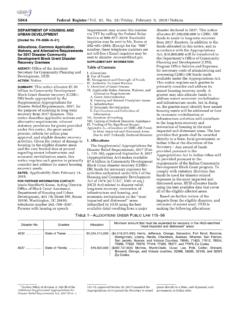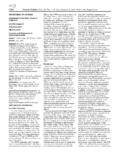Transcription of 30889 Proposed Rules Federal Register - epa.gov
1 This section of the Federal Register contains notices to the public of the proposedissuance of Rules and regulations. Thepurpose of these notices is to give interestedpersons an opportunity to participate in therule making prior to the adoption of the RulesFederal Register30889 Vol. 83, No. 127 Monday, July 2, 2018 ENVIRONMENTAL PROTECTION AGENCY 40 CFR Part 745 [EPA HQ OPPT 2018 0166; FRL 9976 04] RIN 2070 AJ82 Review of the Dust-Lead Hazard Standards and the Definition of Lead- Based Paint AGENCY: Environmental Protection Agency (EPA). ACTION: Proposed rule. SUMMARY: Addressing childhood lead exposure is a priority for EPA. As part of EPA s efforts to reduce childhood lead exposure, EPA evaluated the current dust-lead hazard standards (DLHS) and the definition of lead-based paint (LBP). Based on this evaluation, EPA is proposing to lower the DLHS from 40 mg/ft2and 250 mg/ft2to 10 mg/ ft2and 100 mg/ft2on floors and window sills, respectively.
2 EPA is proposing no changes to the current definition of LBP due to insufficient information to support such a change. DATES: Comments must be received on or before August 16, 2018. ADDRESSES: Submit your comments, identified by docket identification (ID) number EPA HQ OPPT 2018 0166, by one of the following methods: Federal eRulemaking Portal: http:// Follow the online instructions for submitting comments. Do not submit electronically any information you consider to be Confidential Business Information (CBI) or other information whose disclosure is restricted by statute. Mail: Document Control Office (7407M), Office of Pollution Prevention and Toxics (OPPT), Environmental Protection Agency, 1200 Pennsylvania Ave. NW, Washington, DC 20460 0001. Hand Delivery: To make special arrangements for hand delivery or delivery of boxed information, please follow the instructions at Additional instructions on commenting or visiting the docket, along with more information about dockets generally, is available at http:// FOR FURTHER INFORMATION CONTACT: For technical information contact: John Yowell, National Program Chemicals Division, Office of Pollution Prevention and Toxics, Environmental Protection Agency, 1200 Pennsylvania Ave.
3 NW, Washington, DC 20460 0001; telephone number: 202 564 1213; email address: For general information contact: The TSCA-Hotline, ABVI-Goodwill, 422 South Clinton Ave., Rochester, NY 14620; telephone number: (202) 554 1404; email address: SUPPLEMENTARY INFORMATION: I. Executive Summary A. Does this action apply to me? You may be potentially affected by this action if you conduct LBP activities in accordance with 40 CFR , if you operate a training program required to be accredited under 40 CFR , if you are a firm or individual who must be certified to conduct LBP activities in accordance with 40 CFR , or if you conduct rehabilitations in accordance with 24 CFR 35. You may also be affected by this action, in accordance with 40 CFR , as the seller or lessor of target housing, which is most pre-1978 housing. See 40 CFR For further information regarding the authorization status of States, territories, and Tribes, contact the National Lead Information Center at 1 800 424 LEAD (5323).
4 The following list of North American Industrial Classification System (NAICS) codes is not intended to be exhaustive, but rather provides a guide to help readers determine whether this document applies to them. Potentially affected entities may include: Building construction (NAICS code 236), , single-family housing construction, multi-family housing construction, residential remodelers. Specialty trade contractors (NAICS code 238), , plumbing, heating, and air-conditioning contractors, painting and wall covering contractors, electrical contractors, finish carpentry contractors, drywall and insulation contractors, siding contractors, tile and terrazzo contractors, glass and glazing contractors. Real estate (NAICS code 531), , lessors of residential buildings and dwellings, residential property managers. Child day care services (NAICS code 624410). Elementary and secondary schools (NAICS code 611110), , elementary schools with kindergarten classrooms.
5 Other technical and trade schools (NAICS code 611519), , training providers. Engineering services (NAICS code 541330) and building inspection services (NAICS code 541350), , dust sampling technicians. Lead abatement professionals (NAICS code 562910), , firms and supervisors engaged in LBP activities. Federal agencies that own residential property (NAICS code 92511, 92811). Property owners, and property owners that receive assistance through Federal housing programs (NAICS code 531110, 531311). B. What is the Agency s authority for taking this action? EPA is proposing this rule under sections 401, 402, 403, and 404 of the Toxic Substances Control Act (TSCA), 15 2601 et seq., as amended by Title X of the Housing and Community Development Act of 1992 (also known as the Residential Lead-Based Paint Hazard Reduction Act of 1992 or Title X ) (Pub. L. 102 550) (Ref. 1). TSCA section 403 (15 2683) mandates EPA to identify LBP hazards for purposes of administering Title X and TSCA Title IV.
6 Under TSCA section 401 (15 2681), LBP hazards are defined as conditions of LBP and lead- contaminated dust and soil that would result in adverse human health effects, and lead-contaminated dust is defined as surface dust in residential dwellings that contains lead in excess of levels determined to pose a threat of adverse health effects.. As defined in TSCA section 401 (15 2681(9)), LBP means: paint or other surface coatings that contain lead in excess of milligrams per centimeter squared or percent by weight or (A) in the case of paint or other surface coatings on target housing, such lower level as may be established by the Secretary of [HUD], as defined in section 4822(c) of Title 42, or (B) in the case of any other paint or VerDate Sep<11>2014 17:04 Jun 29, 2018 Jkt 244001 PO 00000 Frm 00001 Fmt 4702 Sfmt 4702 E:\FR\FM\ 02 JYP1daltland on DSKBBV9HB2 PROD with PROPOSALS30890 Federal Register / Vol.
7 83, No. 127 / Monday, July 2, 2018 / Proposed Rules surface coatings, such other level as may be established by the Administrator [of EPA]. The amendments to the regulations on LBP activities are being Proposed pursuant to TSCA section 402 (15 2682). The amendments to the regulations on the authorization of State and Tribal Programs are being Proposed pursuant to TSCA section 404 (15 2684). This Proposed rule is being issued in compliance with the December 27, 2017 decision ( Opinion ) of the Ninth Circuit Court of Appeals, and the subsequent March 26, 2018 order that directed the EPA to issue a Proposed rule within ninety (90) days from the filed date of this order (Ref. 2) (Ref. 3). C. What action is the Agency taking? EPA established dust-lead hazard standards (DLHS) of 40 mg/ft2for floors and 250 mg/ft2for window sills in a final rule entitled, Identification of Dangerous Levels of Lead.
8 See 66 FR 1206, January 5, 2001, also known as the LBP Hazards Rule (Ref. 4). EPA is proposing to amend the DLHS set by the LBP Hazards Rule to lower the DLHS for floor dust to 10 mg/ft2and to lower the DLHS for window sill dust to 100 mg/ ft2. EPA is requesting comment on the achievability and appropriateness of the Proposed DLHS. EPA is requesting comments on all aspects of this proposal, including any options presented in EPA s Technical Support Document that accompanies this proposal (Ref. 5), including taking comment on keeping the DLHS at the current levels. EPA and HUD adopted the statutory definition of LBP in a joint final rule entitled, Requirements for Disclosure of Known Lead-Based Paint and/or Lead-Based Paint Hazards in Housing. See 61 FR 9064, March 6, 1996, also known as the Disclosure Rule (Ref. 6). EPA is proposing no changes to the current definition of LBP due to insufficient information to support such a change.
9 D. Why is the Agency taking this action? Reducing childhood lead exposure is an EPA priority, and EPA is collaborating with our Federal partners to reduce lead exposures and to explore ways to increase our relationships and partnerships with States, Tribes, and localities. EPA Administrator Scott Pruitt hosted a meeting of principals from the 17 Federal departments and agencies on the President s Task Force on Environmental Health Risks and Safety Risks to Children in February 2018. At the meeting, the Task Force members committed to make addressing childhood lead exposure a priority and to develop a Federal strategy to reduce childhood lead exposures. Today s proposal is a component of EPA s prioritizing the important issue of childhood lead exposure. In the 2001 final rule that set the initial hazard standards under TSCA section 403, EPA examined the health effects of various dust-lead loadings, and analyzed those values against issues of practicality to determine the appropriate standards, in accordance with the statute.
10 At that time, the Centers for Disease Control and Prevention (CDC) identified a test result of 10 mg/dL of lead in blood or higher in children as a level of concern . Based on the available science at the time, EPA explained that health effects at blood lead levels (BLLs) lower than 10 mg/dL were less well substantiated. Further, the Agency acknowledged that the standards were based on the best science available to the Agency, and if new data were to become available, EPA would consider changing the standards to reflect these data. (Ref. 4) New data have become available since the 2001 final rule that indicates that health risks exist at lower BLLs than previously recognized. The CDC now considers that no safe BLL in children has been identified (Ref. 7), and is no longer using the term level of concern and is instead using the reference value to identify children who have been exposed to lead and who should undergo case management (Ref.)











